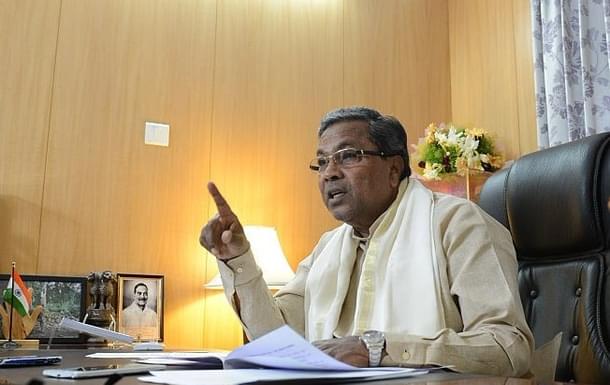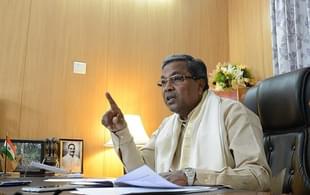Politics
Siddaramaiah’s Flag-And-Federalism Plea Is Fine, But He Needs To Take The Logic Further
R Jagannathan
Mar 17, 2018, 02:23 PM | Updated 02:23 PM IST
Save & read from anywhere!
Bookmark stories for easy access on any device or the Swarajya app.


Karnataka Chief Minister Siddaramaiah has got it more or less right in his flag-and-language message, which includes the right mix of regional and national pride. He is on the right side of history in demanding greater decentralisation of resources and autonomy, but – as always – he fails to see that the logic cuts deeper than what he intends.
Siddaramaiah can probably be accused of raising issues of regional pride and Hindi imposition just because he faces a must-win assembly election in the coming two months, but if the Bharatiya Janata Party (BJP) can play the nationalist tune, he is well within his rights to play the sub-nationalism card.
We should analyse his statement, made on his Facebook page, both for its good and bad points.
The good points first.
The Chief Minister said: “I don’t think the demands for greater federal autonomy and recognition of regional identity are inconsistent with our nation. Karnataka prides in (its) Kannada identity. The oldest written document (in stone) in Kannada found at Halmidi, Hassan District, dates back to (the) 2nd century AD. The oldest Kannada kingdom under the Kadamabas of Banvasi ruled the state during the 4th century AD. We have been using a red and yellow flag since decades. Yet, Karnataka, as our poet laureate Kuvempu said, is the daughter of Bharata, the Indian nation (Jaya Bharatha Jananiya Tanujathe).”
Comment: This is exactly the right tone, and sensible, too. There can be no nationalism without regional pride. But we need to add another line: there can be no regional pride without sub-regional pride. India is diverse not only at the national level, but at the state level too.
The Chief Minister further said: “Many of the languages and cultures of the states pre-date the Indian identity. Yet, we Indians are bound by a common history, common civilisation, and a common destiny. My identity as a proud Kannadiga is not inconsistent with my identity as a proud Indian.”
Comment: Well said, though one can quarrel with the claim that state identity predated the Indian identity. Pan-Indian empires date back to the Mauryan dynasty, and hence ideas of Indian nationhood cannot be said to post-date the creation of regional identities. However, it is entirely possible that sub-regional and regional identities of various kinds predated the idea of Hindu or Indian nationhood.
On the language issue, Siddaramaiah said: “So, in Karnataka when we speak about primacy to Kannada, argue against imposition of Hindi language, or call for the adoption of a state flag, we are confident we are contributing to (the) building of a strong India; for, a confident Indian nation is confident about the individuality of all her daughters(states).”
Comment: No issue here. India is a Union of States, and so India is built ground-up from the states. No states, no India. But our states too are built ground-up from various sub-regional identities and geographies, including tribal regions that have often been left alone to develop by themselves. On the red-and-yellow flag, there is absolutely no reason why Karnataka should not have its own standard, but again the logic can go sub-regional as well. What if Bengaluru city wants its own cosmopolitan flag, or Belgaum (renamed Belagavi by Siddaramaiah), for that matter. Will Siddaramaiah allow it?
We could also ask: what if Yogi Adityanath’s Uttar Pradesh decided to have a saffron flag? In fact, what if all the Hindi-speaking states did that? Will that be accepted as equally valid? After all, at one point before independence, the Congress itself was thinking of having a saffron flag. You can’t, on the one hand, want a Karnataka flag and oppose a Hindi state seeking its regional identity and flag.
Siddaramaiah can be – and should be – against Hindi hegemony, but one wonders why this logic should not apply to English? Or, for that matter, Kannada’s hegemony over its sister tongues in the state. As author and historian Vikram Sampath wrote in Swarajya last year, “the oral languages and dialects of Karnataka, like Beary, Tulu, Kodava, Konkani, Siddi and Hakki Pikki, which are…bereft of scripts, feel terribly threatened by the hegemony of official Kannada, which in turn fears a Hindi, which eventually is intimidated by English!”
The moral: for every regional cause, there could be a sub-regional cause that is equally valid. So, we need to be sensitive to all of this. Just as Andhra had a sub-regional Telangana identity, parts of Karnataka may want their own too, in the future.
Then, the Chief Minister talked about federalism: “Let me raise certain issues of federalism that affect us on a day-to-day basis. Relatively well-developed states like Karnataka, Kerala, Tamil Nadu, Andhra Pradesh and Maharashtra contribute more to central taxes than what they get in return from the centre. What we get from the centre comes in the form of state’s share in devolution of central taxes and grants under centrally-sponsored schemes. The grants under centrally-sponsored schemes come with strings attached. Schemes are designed keeping the entire country in mind and we are forced to implement them and provide our share. We need a system where states receive a larger portion of the taxes collected from our states and the share of centrally-sponsored schemes must go down. The central schemes, if at all needed, need to be flexible so that we can tailor them to our needs.”
Comment: These comments are unexceptionable. The case for greater federalism and devolution of resources is solid. The number of federally sponsored schemes should be brought down steadily and finally eliminated or flexible enough for states to refashion them according to their needs.
But he went on to make more controversial points: “Historically, the South has been subsidising the north. Six states south of the Vindhyas contribute more taxes and get less. For example, for every one rupee of tax contributed by Uttar Pradesh that state receives Rs 1.79. For every one rupee of tax contributed by Karnataka, the state receives Rs 0.47. While I recognise the need for correcting regional imbalances, where is the reward for development?”
Comment: This is a cheap shot and part of his anti-Hindi posture. He could say the same about Bengaluru too – which generates the bulk of the state’s taxes, but the money is not spent on the city alone. India is not a money-back federation. If richer states – and richer cities – do not contribute to the poorer states and the hinterland, there will be no nation left. So, while Siddaramaiah may be right to ask for more, he cannot expect that the bulk of the taxes raised in the state ought to come back to it.
Second, not all of Karnataka’s wealth and tax revenues are the result of its own efforts. The information technology (IT) industry was helped mostly by central policies that offered decades of tax-free income to Karnataka-based companies like Infosys and Wipro. Before IT, the entire gamut of defence and electronics industries created in an around Bengaluru – Hindustan Aeronautics Limited, Indian Telephone Industries Limited, Bharat Electronics Limited, etc – was substantially financed by the Centre. This central investment and revenue forgone contributed to making Karnataka the rich state it is today. And let’s not forget the freight equalisation scheme, which made key minerals available at the same price for all states, and which dented the geographical advantages of several mineral-rich eastern states, including Bihar and West Bengal. Western India and coastal states benefited the most.
Siddaramaiah’s unkindest cut related to the population issue: “The states of the South have nearly reached replacement levels of population growth. Yet, population is a prominent criteria for the devolution of central taxes. For how long can we keep incentivising population growth?”
Comment: For decades, “secularists” have been telling us that higher Muslim birth rates will level off – and they are falling – but no Congress Chief Minister asked how long Hindus will be incentivising Muslim population growth. But Siddaramaiah is asking the same question, only painting the Hindi-speaking states as villains. The answer is probably two or three decades. He should know that population growth rates fell to replacement levels in Karnataka and other southern states as a result of development; the same will happen in the Hindi belt.
Another point: even though resources get allocated based on population, Lok Sabha seats are frozen in time to levels of population at the time of independence. This benefits southern states, including Karnataka, which get more Lok Sabha seats than their population share.
The big takeout from Siddaramaiah’s comments are that the boot could quite easily shift to the other foot. Just as growth momentum shifts from one regional node to another in the world (it has shifted from the United States-European axis to Asia over the last quarter century), the same will happen in India too, as the ageing southern states face a demographic slowdown, and the younger states speed up. India’s future growth may well be driven by the Hindi belt (assuming they get their governance right), and Karnataka would be ill-advised to think that it has no stake in their upliftment. Transfer of revenues from the south to the north will be paid back in spades in the coming decades as India’s growth engines move northwards.
Jagannathan is former Editorial Director, Swarajya. He tweets at @TheJaggi.





